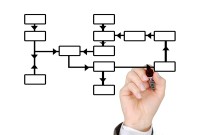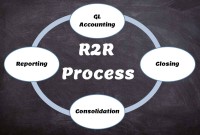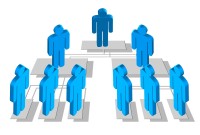- Home
- Business Processes
- Industry Knowledge
- Aerospace Industry
- Automotive Industry
- Banking Domain
- BFSI Industry
- Consumer/ FMCG Industry
- Chemicals Industry
- Engineering & Construction
- Energy Industry
- Education Domain
- Finance Domain
- Hospitality Domain
- Healthcare Industry
- Insurance Domain
- Retail Industry
- Travel and Tourism Domain
- Telecom Industry
- Leadership Skills
- eLearning
- Home
- Business Processes
- General Ledger (Record to Report)
- Organizational Elements
Organizational Elements
McKinsey 7S Framework is most often used as an organizational analysis tool to assess and monitor changes in the internal situation of an organization. The model is based on the theory that, for an organization to perform well, seven elements need to be aligned and mutually reinforcing.
McKinsey 7S Framework is most often used as an organizational analysis tool to assess and monitor changes in the internal situation of an organization. The model is based on the theory that, for an organization to perform well, following seven elements need to be aligned and mutually reinforcing:
Hard Elements - Hardware of Organizational Success
-
Strategy: The integrated vision and direction of the company
A set of actions that the company starts with and which it must maintain. Strategy is the manner in which the organization derives, articulates, communicates and implements it's vision and direction. Strategy is the purpose of the business and the way the organization seeks to enhance its competitive positioning and competitive advantage.
Strategic thinking involves the understanding of basic economics of business; identifying one’s sources of competitive advantage, and allocating resources to ensure that ones distinctive capabilities remain strong.
-
Structure - The organizational chart of the company
Structure defines how people, tasks, work is organized and represents the way business divisions and units are organized and includes the information of who is accountable to whom. In other words, structure is the organizational chart of the firm. It is also one of the most visible and easy to change elements of the framework. Structure allow the firm to focus on areas that are deemed important for its evolution. This includes division of activities; integration and coordination mechanisms. Functional superiority can only be achieved if there is enough reliability and focus within each business unit.
-
Systems - The decision making procedures of the company
Systems refer to policies and procedures that govern the way in which the organization acts within itself and its external environment. These processes and information flows link the organization together and used by staff to get the work done. This includes computer systems, operational systems, HR systems, etc., which reveal business’ daily activities and how decisions are made. Systems do not only refer to hard copy reports and procedures but also to
informal mechanisms such as meetings and conflict management routines.
Soft Elements - Software of Organizational Success
-
Style - The management style of the company
Style represents the way the company is managed by top-level managers, how they interact, what actions do they take and their symbolic value. How managers behave, leadership style, unwritten norms of behavior and organizational culture etc.
-
Staff - The employees of the company
This element is concerned with how the company develops managers (current and future) and employees. Their selection, training, reward and recognition, retention, motivation and assignment to work etc. Identifying what type and how many employees an organization will need and how they will be recruited, trained and deployed.
-
Shared Values - The key beliefs and aspirations and guiding values of the company
These values define the firm's key beliefs and aspirations that form the core of its corporate culture. These values shapes the organizational culture as the employees share the same goals guiding values. Values act as an organization's conscience, providing guidance in times of crisis and are the foundation of every organization.
Values are intangibles that affects employees (treating them with dignity), customers (treating them with fairness) and society (making a social contribution).
-
Skills - The dominant capabilities of the company
Dominant attributes, competence or capabilities that exist in the organization. It refers to the fact that employees have the skills necessary to execute company’s strategy. Skills enables its employees to achieve its objectives.
Organization is a system of consciously coordinated activities of two or more persons in order to achieve a common goal. As per the model these seven internal aspects of an organization need to be aligned if it is to be successful. The 7Ss framework provides a useful framework for analyzing the strategic attributes of an organization. Whatever the type of change – restructuring, new processes, organizational merger, new systems, change of leadership, and so on – the model can be used to understand how the organizational elements are interrelated, and to ensure that the wider impact of changes made in one area is taken into consideration. The model can be applied to many situations and is a valuable tool when organizational design is at question.
The most common uses of the framework are:
- To facilitate organizational change
- To help implement new strategy
- To identify how each area may change in a future
- To facilitate the merger of organizations
Organizational structure aligns and relates parts of an organization, so it can achieve its maximum performance.
Organizational structure sets out who does what within a company and specifies who answers to whom.
A strategic, carefully planned organizational structure helps a business run effectively and efficiently.
It helps determine how your products are produced, distributed, marketed and sold.
Structure is also dependent on your company’s unique mission and goals.
Regardless of the type of structure you choose, you’ll find key elements that they all have in common.
One of the most important components of your organizational structure is defining who’s in charge.
It’s important that you have a clear defined chain of command.
How and where your products or services are produced is also considered within your business structure.
An organization’s structure also maps out how products are delivered to customers.
Each of these elements affects how workers engage with each other, management and their jobs in order to achieve the employer’s goals.
Related Links
You May Also Like
-
A joint venture (JV) is a business agreement in which the parties agree to develop, for a finite time, a new entity and new assets by contributing equity. They exercise control over the enterprise and consequently share revenues, expenses and assets. A joint venture takes place when two or more parties come together to take on one project.
-
Hierarchical Organization Structures
Hierarchical structure is typical for larger businesses and organizations. It relies on having different levels of authority with a chain of command connecting multiple management levels within the organization. The decision-making process is typically formal and flows from the top down.
-
Defining Organizational Hierarchies
A hierarchy is an ordered series of related objects. You can relate hierarchy with “pyramid” - where each step of the pyramid is subordinate to the one above it. One can use drill up or down to perform multi-dimensional analysis with a hierarchy. Multi-dimensional analysis uses dimension objects organized in a meaningful order and allows users to observe data from various viewpoints.
-
GL - Unearned / Deferred Revenue
Unearned revenue is a liability to the entity until the revenue is earned. Learn the concept of unearned revenue, also known as deferred revenue. Gain an understanding of business scenarios in which organizations need to park their receipts as unearned. Look at some real-life examples and understand the accounting treatment for unearned revenue. Finally, look at how the concept is treated in the ERPs or automated systems.
-
GL - Different Accounting Methods
The accounting method refers to the rules a company follows in reporting revenues and expenses. Understand the two common systems of bookkeeping, single, and double-entry accounting systems. Learners will also understand the two most common accounting methods; cash and accrual methods of accounting and the advantages and disadvantages of using them.
-
Record to report (R2R) is a finance and accounting management process that involves collecting, processing, analyzing, validating, organizing, and finally reporting accurate financial data. R2R process provides strategic, financial, and operational feedback on the performance of the organization to inform management and external stakeholders. R2R process also covers the steps involved in preparing and reporting on the overall accounts.
-
What Is a General Ledger? General Ledger (also known in accounting as the GL or the Nominal Ledger) is at the heart of any accounting system. A general ledger is the master set of accounts that summarize all transactions occurring within an entity. Ledger is the skillful grouping and presentation of the Journal entries. Learn the accounting fundamentals, general ledger process, and general ledger flow.
-
In this article we will discuss various types of "Management Entities". Various types of operational units, are created by management, to effectively run, manage and control their business. Different types of functional units, and divisional units, are widely used across industry.
-
Divisional Organizational Structures
The divisional structure or product structure consists of self-contained divisions. A division is a collection of functions which produce a product. It also utilizes a plan to compete and operate as a separate business or profit center. Divisional structure is based on external or internal parameters like product /customer segment/ geographical location etc.
-
Different Types of Organizational Structures
Modern business organizations run multiple product and service lines, operate globally, leverage large number of registered legal entities, and operate through complex matrix relationships. To stay competitive in the current global business environment, they must often develop highly diverse and complex organizational structures that cross international borders.
Explore Our Free Training Articles or
Sign Up to Start With Our eLearning Courses

About Us
Learning
© 2023 TechnoFunc, All Rights Reserved











